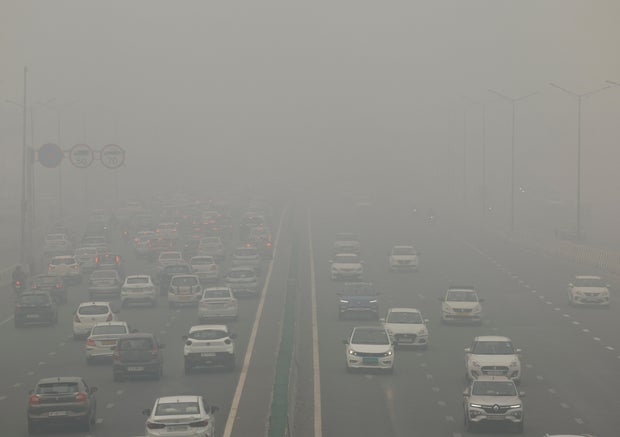CBS News
India’s worsening, “severe plus” air pollution forces even more dramatic safety measures

New Delhi — Authorities in India’s sprawling capital city imposed even stricter emergency measures Monday in a bid to prevent illness as thick smog blanketed New Delhi. The air pollution was even worse, and considerably so, than last week, when the annual smog first descended.
Delhi’s air quality Index (AQI) — a measure of the severity of air pollution based on the levels of five toxins — shot up to 499 in some places Monday morning. That meant a categorization of “severe plus” on India’s System of Air Quality Forecasting and Research (SAFAR) scale, and “hazardous” under the U.S. AQI measurement system.
The thick smog never lifted Monday, even as night descended. It disrupted dozens of flights and trains as visibility remained low all around the capital.
India’s Commission for Air Quality Management announced on Monday it had implemented stage 4 of the Graded Response Action Plan (GRAP) — bringing the strictest emergency measures offered to mitigate the impacts and try to reduce pollution.
The stage 4 measures, which are likely to remain in place until conditions improve, include:
- All trucks except those carrying essential items are barred from entering Delhi.
- All commercial vehicles registered outside Delhi are barred from entering the city, though there is an exception for EVs and those running on cleaner fuels.
- All construction activities, including work on roads, flyovers, power lines, pipelines and other public projects, are halted.
- Schools switch to online teaching for all students, except for grades 10 and 12, with all other in-person classes being suspended.
- All employers, both state and private, in Delhi have been advised to have only 50% of their workforces come into their offices, with the rest working from home.
- Authorities may also order work federal government employees to work from home.
India’s Supreme Court steps in
India’s Supreme Court on Monday chastized the Delhi government over the worsening air quality in the capital and asked why it had waited for the AQI to cross the 300 mark before imposing the strictest emergency measures. Any AQI reading over 300 falls within the worst, hazardous level on the U.S. scale.
“How could the government take such a risk?” the Supreme Court asked.
Anushree Fadnavis/REUTERS
The court has also asked the federal government to share real-time satellite data to show the impact of farm waste burning with state governments, in the hope of encouraging action at the state level to tackle the polluting, highly common practice in Delhi’s neighboring states.
Delhi sees a major spike in air pollution every very winter due to several factors, including the burning of farm waste or “stubble” in the adjoining states of Haryana and Punjab. Fireworks and climatological factors also contribute to the smog.
CBS News
Stock market plummets after Fed forecasts fewer rate cuts in 2025

U.S. stocks plummeted in one of their worst days of the year after the Federal Reserve forecast Wednesday it may deliver fewer shots of adrenaline for the economy in 2025 than it had earlier projected.
The S&P 500 fell 178 points, or 3%, pulling it further from its all-time high set a couple weeks ago. The Dow Jones Industrial Average lost 1,123 points, or 2.6%, while the Nasdaq composite dropped 3.6%.
The Fed said Wednesday it’s cutting its benchmark interest rate for a third time this year, continuing the sharp turnaround begun in September when it started lowering rates from a two-decade high to support the job market. Wall Street loves lower interest rates, but the Dec. 18 cut had been widely expected by Wall Street.
Why is the stock market down today?
Investors were unsettled by the Fed’s forecast for fewer cuts in 2025, even though many economists had already been paring their expectations given sticky inflation.
“Markets have a really bad of habit of overreacting to Fed policy moves,” Jamie Cox, managing partner for Harris Financial Group, said in an analyst note. “The Fed didn’t do or say anything that deviated from what the market expected—this seems more like, I’m leaving for Christmas break, so I’ll sell and start up next year.”
The bigger question centers on how much more the Fed could cut next year. A lot is riding on it, particularly after expectations for a series of cuts in 2025 helped the U.S. stock market set an all-time high 57 times so far in 2024.
Fed officials released projections on Wednesday showing the median expectation among them is for two more cuts to the federal funds rate in 2025, or half a percentage point’s worth. That’s down from the four cuts they had expected just three months ago.
“We are in a new phase of the process,” Fed Chair Jerome Powell said. The central bank has already quickly eased its main interest rate by a full percentage point, to a range of 4.25% to 4.50%, since September.
What happened to the stock market today?
Asked why Fed officials are looking to slow their pace of cuts, Powell pointed to how the job market looks to be performing well overall and how recent inflation readings have picked up. He also cited uncertainties that will require policy makers to react to upcoming, to-be-determined changes in the economy.
While lower rates can goose the economy by making it cheaper to borrow and boosting prices for investments, they can also offer more fuel for inflation.
Powell said some Fed officials, but not all, are also already trying to incorporate uncertainties inherent in a new administration coming into the White House. Worries are rising on Wall Street that President-elect Donald Trump’s preference for tariffs and other policies could further juice inflation, along with economic growth.
“When the path is uncertain, you go a little slower,” Powell said. It’s “not unlike driving on a foggy night or walking into a dark room full of furniture. You just slow down.”
One official, Cleveland Fed President Beth Hammack, thought the central bank should not have even cut rates this time around. She was the lone vote against Wednesday’s rate cut.
Wall Street’s worst performers
The reduced expectations for 2025 rate cuts sent Treasury yields rising in the bond market, squeezing the stock market.
The yield on the 10-year Treasury rose to 4.51% from 4.40% late Tuesday, which is a notable move for the bond market. The two-year yield, which more closely tracks expectations for Fed action, climbed to 4.35% from 4.25%.
On Wall Street, stocks of companies that can feel the most pressure from higher interest rates fell to some of the worst losses.
Stocks of smaller companies did particularly poorly, for example. Many need to borrow to fuel their growth, meaning they can feel more pain when having to pay higher interest rates for loans. The Russell 2000 index of small-cap stocks tumbled 4.4%.
Elsewhere on Wall Street, General Mills dropped 3.1% despite reporting a stronger profit for the latest quarter than expected. The maker of Progresso soups and Cheerios said it will increase its investments in brands to help them grow, which pushed it to cut its forecast for profit this fiscal year.
Nvidia, the superstar stock responsible for a chunk of Wall Street’s rally to records in recent years, fell 1.1% to extend its weekslong funk. It has dropped more than 13% from its record set last month and fallen in nine of the last 10 days as its big momentum slows.
“As we wrote in our 2025 outlook a couple of weeks ago, stretched positioning and sentiment left stocks vulnerable to a sell-off,” Jeff Buchbinder, chief equity strategist for LPL Financial said in a note about today’s market sell-off. “The big jump in inflation expectations and related bond sell-off was a convenient excuse. Once support from tech evaporated, no other groups were able to step in to fill that gaping hole.”
CBS News
Trump comes out against Johnson bill that would avert shutdown

Watch CBS News
Be the first to know
Get browser notifications for breaking news, live events, and exclusive reporting.
CBS News
Why NASA delayed the return date for Starliner astronauts still in space

Watch CBS News
Be the first to know
Get browser notifications for breaking news, live events, and exclusive reporting.










